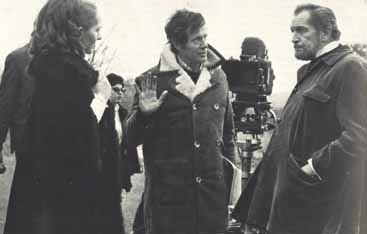
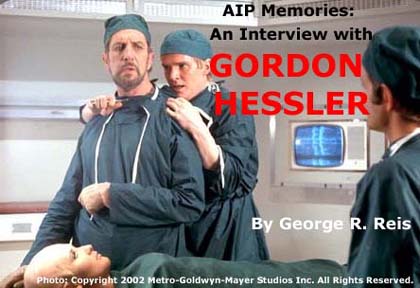 In
celebration of MGM Home Video's DVD release of THE OBLONG
BOX/SCREAM AND SCREAM AGAIN (due out August 27), DVD Drive-In presents
this exclusive new interview with director Gordon Hessler. Mr. Hessler was kind
enough to meet me in person to discuss the four films he did for American International
Pictures--THE OBLONG BOX (1969), SCREAM
AND SCREAM AGAIN (1970), CRY OF THE BANSHEE
(1970) and MURDERS IN THE RUE MORGUE (1971).
In
celebration of MGM Home Video's DVD release of THE OBLONG
BOX/SCREAM AND SCREAM AGAIN (due out August 27), DVD Drive-In presents
this exclusive new interview with director Gordon Hessler. Mr. Hessler was kind
enough to meet me in person to discuss the four films he did for American International
Pictures--THE OBLONG BOX (1969), SCREAM
AND SCREAM AGAIN (1970), CRY OF THE BANSHEE
(1970) and MURDERS IN THE RUE MORGUE (1971).
George
Reis: How did you get started with AIP?
Gordon Hessler: I was asked to produce a film, DE SADE, for AIP while I was in Los Angeles that was taking place in Munich, Germany. I flew into London and met the writer, and the director was supposed to be there, but he never showed up. He didn't come to the meeting; he was sick or something like that. Having met the writer, I flew to Munich to set up the film about eight weeks before they were going to start shooting. I was there preparing the production and then I was told that the original director was not going to make the picture. So we waited for a while, and finally the American director who did ZULU, Cy Endfield, came in to do it. This was a big picture for AIP, which usually made very cheap pictures, and I was an outsider. I was not an employee, just a freelance director. My position got very shaky there, even though I was very friendly with everybody. I was actually fired from the job because the local people employed by AIP wanted to produce the picture rather than have an outsider like me. But they did give me a consolation. They said, "Look, we want to put you on another picture in Ireland and you can produce that." So, I thought that was fine as it was going to be a horror picture shot in Ireland. They sent me to Ireland, I looked at the facilities, and decided to bring the production to London, at Shepperton Studios. I had a pretty free hand because everybody was concentrating on DE SADE at the time. And Michael Reeves, who was supposed to direct that picture, was to direct this one, THE OBLONG BOX. He was on it for a short while, but then he got sick. He must have been already sick with some mental health problems.
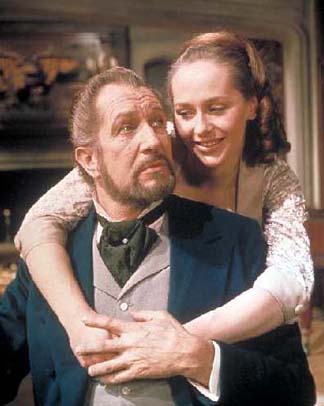 George
Reis: Did Michael Reeves
actually shoot anything for THE OBLONG BOX?
George
Reis: Did Michael Reeves
actually shoot anything for THE OBLONG BOX?
Gordon Hessler: No, he hated the project and he loathed the script. Of course, it was a big comedown because he was going to do the biggest picture they had before he got sick, and then he was to do this standard horror picture. When I met with him, he was doing electric shock treatment. I was staggered! I assumed he had some sort of mental health problems of some kind, I don't know what it was. I never got to know him that well. He was very talented, extremely talented. WITCHFINDER GENERAL is a wonderful picture. I didn't really meet with him that much because gradually, he just couldn't do THE OBLONG BOX. Eventually I took the whole project over and directed and produced it. AIP didn't care at the time about this picture because they were too involved with all the production problems of DE SADE. That film, we moved it from Munich to Berlin to shoot. So I actually went to Berlin for two or three works before going to England to do THE OBLONG BOX.
George
Reis: There are often rumors that you actually directed parts 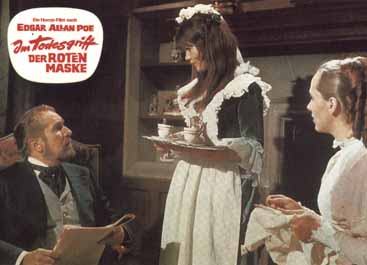 of
DE SADE. Is that true?
of
DE SADE. Is that true?
Gordon Hessler: No, I was only on it shortly on a production level. Then I was totally concentrated on this horror picture, which is kind of a formula script. The way they worked, I assume, because Hammer worked the same way, is they'd have a poster drawn with their star in it and present it to the distributor as their next picture. The script was then written around that. It happened to be an English writer/director who had written the script, Lawrence Huntington. I never met him, it was just a script that arrived. Christopher Wicking was brought in originally by Michael Reeves, and that's how I met him. Wicking did an enormous amount of re-writing on THE OBLONG BOX. So my association with him began as a result of working on this film together. Then he worked on all the pictures that I did for AIP.
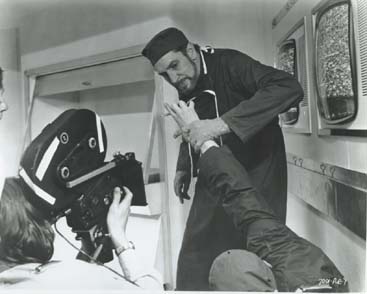 George
Reis: How did you get along with Christopher Wicking for the first time
on that film?
George
Reis: How did you get along with Christopher Wicking for the first time
on that film?
Gordon Hessler:
He's a highly intelligent fellow, very witty. He's a wonderful guy. On SCREAM
AND SCREAM AGAIN, he did extraordinary work on the script. That was really a
pulp book, a throwaway book that you read on a train. There was nothing in it,
just empty pieces of action. But it was Chris who gave it a whole new level
by using it as a political process of what might happen in the future. That
is what made the picture, he's the one that came up with all those ideas, yet
he still managed to keep the nuances of the sort of pulp fiction novel. He was
a fine writer, I thought. He had some very good ideas. It's funny because we
never thought much of those films. They were just formula pictures as far as
we were concerned, but we enjoyed making  them.
The problem was what do you do with a script, how do you solve a problem? CRY
OF THE BANSHEE had the same problem. We got the script from AIP--somebody had
written it and sent it to us, and we were asked to make it. The film was sold
and we had to have it finished by a certain time. Chris Wicking and I went to
Scotland to make a whole different picture about witches. The whole of AIP got
so alarmed because we were changing it so much. They came down on us and said
that we could alter it 10 percent, but no more than that. So all of our work
went down the drain on CRY OF THE BANSHEE. Out of all the films I did for AIP,
I think it's the least interesting.
them.
The problem was what do you do with a script, how do you solve a problem? CRY
OF THE BANSHEE had the same problem. We got the script from AIP--somebody had
written it and sent it to us, and we were asked to make it. The film was sold
and we had to have it finished by a certain time. Chris Wicking and I went to
Scotland to make a whole different picture about witches. The whole of AIP got
so alarmed because we were changing it so much. They came down on us and said
that we could alter it 10 percent, but no more than that. So all of our work
went down the drain on CRY OF THE BANSHEE. Out of all the films I did for AIP,
I think it's the least interesting.
 George
Reis: Most critics say that about CRY OF THE BANSHEE, but I quite enjoy
it.
George
Reis: Most critics say that about CRY OF THE BANSHEE, but I quite enjoy
it.
Gordon Hessler: I must say that Wilfred Josephs' music held the picture up, it made it more mysterious.
George Reis: When you say that they didn't want the script altered, who did you report to, Louis M. "Deke" Heyward?
Gordon Hessler: Yes, Deke Heyward was a wonderful character, literally running AIP in London, which was where they were making all their movies at the time. They had a staff in Los Angeles, but they weren't making any movies, and of course they were very jealous of that London department. Deke had a tiny office and since he collected art, he had all these paintings as well as an organ there (laughs).
George Reis: What was your relationship like with Deke Heyward?
Gordon Hessler: I always got along well with him. He was very politically adept at handling things at AIP. He would protect you from [Sam] Arkoff and [James] Nicholson because they'd come into town and stay at the Savoy Hotel, and then they'd go in to discuss the picture, or they would see the finished product and make their suggestions.
George Reis:
Obviously they were happy with you, as you continued to wor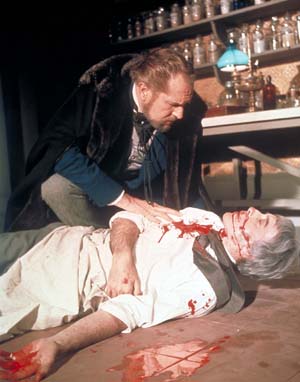 k
with them.
k
with them.
Gordon Hessler: Well, THE OBLONG BOX was very successful for them. They were in tremendous trouble with DE SADE. They didn't get along with Cy Endfield and all sorts of other problems existed. It was the greatest piece of luck that I was fired from it. When I did THE OBLONG BOX, they left me alone, there was nobody there. The day I started, Nicholson came on the set and said, "Good luck." That's it, and he was off. That film was made for £70,000, which is about $250,000. At Shepperton Studios, you could shoot from 8 AM until about 4 PM because of the union. If you wanted to do overtime, you'd have to let them know by lunchtime that you were going to take it one more hour. And only if all the union leaders agreed would they go along with it. It was a very tough assignment to shoot and get finished. Actually, when we were finishing it, I had three or four more days left. They [AIP] said, "Look, we like what you're doing, take an extra week. Can't you make this bigger?" This never happened to me before, so I was happy with the situation and I took an extra week at the studios and built up certain sequences. I can't remember which, but whatever we were shooting, we elaborated on it. And the film did very well for them.
 George
Reis: How did you get along with Vincent Price?
George
Reis: How did you get along with Vincent Price?
Gordon Hessler: Oh, marvelous, he was a marvelous man, highly intelligent. I remember at Shepperton Studios, during THE OBLONG BOX, we had an African prince who was the head of this tribe. So we put them in the film for this dance sequence. I asked Vincent if he wouldn't mind having lunch with this African prince, or king, or whatever he was. You know, most actors always talk about themselves; Vincent was completely the opposite. He talked to him about African art, and all about the various art he knew about and so on. I was just stunned at the conversation and his knowledge. What a unique man.
George Reis: Was it true that he was spending a lot of his earnings on art while staying in England?
Gordon Hessler:
Well, I'm sure he was, he was
very careful with money. What AIP would do was probably give him a very liberal
expense account per week so he could stay at the best hotels. He stayed in tiny
little rooming houses, so I'm sure he was spending the rest of the money on
art. Deke was buying art too.
George Reis: You often used the same actors and actresses in your AIP films, such as Hilary Dwyer.
Gordon Hessler: Hilary Dwyer was almost under contract. I don't know what the situation was, but they liked her and they kept pushing you to use certain actors. I guess the management must have thought she was star material or something like that.
George Reis: I'm sure you're aware that your director's cut of MURDERS IN THE RUE MORGUE has been restored and remastered by MGM and recently aired on U.S. cable TV.
Gordon Hessler:
I'm amazed that MGM had the instinct to do this version of it after so many
years. I was appalled when I originally saw the theatrically released version.
I wrote a five-page letter to Arkoff. I knew it was his picture and he could
do what he wanted with it, but I asked him to do certain things so it would
at least make more sense. But by that time, it was already out and released.
There's another film that I did--which I feel very strongly about--called GIRL
ON A SWING that was terribly mauled. It's awful what Miramax did. They spliced
ten or 15 minutes out of it, and it didn't make any sense. We all wanted to
take our name off of that picture. In my contract, they had to give me a 35mm
print of the original version--it's the only one in existence. But as far as
MURDERS IN THE RUE MORGUE, it seems that someone at MGM is doing some researching
or something, releasing my cut of the film. This cable TV version--which I haven't
yet seen--is apparently the original. I remember the flashbacks were originally
never tinted, but AIP tinted them for the theatrical release. The whole idea
was not to tint them so that you wouldn't know when you're more or less in a
dream sequence or just being puzzled by it. The whole trick in that was instead
of it being a flashback, this would be a flash-forward, which people really
hadn't done  before
at that time. It was a premonition of what was going to happen. When it's tinted,
it's just so obvious. Audiences picked up on it immediately.
before
at that time. It was a premonition of what was going to happen. When it's tinted,
it's just so obvious. Audiences picked up on it immediately.
George Reis: AIP also removed a lot of Lilli Palmer's scenes.
Gordon Hessler: Lilli Palmer had a big part. She was vital to the plot and by cutting her scenes down, it was like she was an extra in the film. I don't know what she must have thought when she saw it, she must have been astounded. She's a fantastic actress when you think about all the films she's done.
George Reis: MURDERS IN THE RUE MORGUE was shot in Spain. Why did AIP decide to do it there rather than England?
Gordon Hessler:
Well, Spain was a very cheap place to film. Hollywood made a great deal of their
large pictures in Spain, where you could get the crowds cheaply and horses,
etc. All the David Lean pictures for Columbia were being made in Spain. You
would bring in a skeleton crew--either from Hollywood or London--and the rest
was a very elaborate, well-trained Spanish crew, and they would give you anything
you wanted. We shot that in Toledo, and the streets there are so similar to
Paris. You couldn't shoot that in London unless you built sets. We just shut
down Toledo when we made tha, and shot in the streets and in this theater--it
was a very French-looking theater. So that's why I chose that.
George Reis: How did Herbert Lom and Jason Robards deal with their roles?
Gordon Hessler: Herbert Lom is a character actor anyway, so he fitted right into the part. Jason Robards was hired by AIP because of his name, and he was quite well respected. Most actors like to play a horror part at some point in their life, so he was brought onboard. He was fine to work with, but about two weeks into the picture, he said, "Gordon, I'm doing the wrong part, I should be doing the other part." I said, "Jason, you're the star, you could've chosen any part you wanted, you just had to ask for it!" It's always the monster who gets the best part in a horror picture, it's much more juicy.
 George
Reis: SCREAM AND SCREAM AGAIN is an extraordinary film, very different
from the typical Poe/Price cycle. Was AIP happy with it?
George
Reis: SCREAM AND SCREAM AGAIN is an extraordinary film, very different
from the typical Poe/Price cycle. Was AIP happy with it?
Gordon Hessler:
Well, they didn't know what the film was about and were always questioning what
I was doing. The editor kept assuring them that everything was fine, but they
didn't quite know what they had as a picture. I'm sure they were a little queasy
when that film came out because Arkoff had to try and sell it. We knew we had
a good film. It was different. It was a science fiction film really, but the
thing is, although the pulp book was very badly written, once Chris Wicking
had put the nucleus of that idea into it, it elevated the whole picture and
made it much more interesting. But all these pictures were made so quickly with
so little money, I think we shot that in three or four weeks. But we had fun
making it.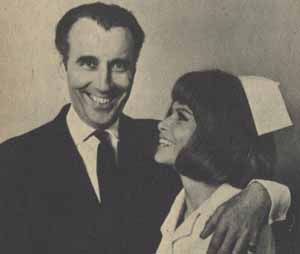
George Reis: You had Christopher Lee in small parts in THE OBLONG BOX and SCREAM AND SCREAM AGAIN. How did you get along with him?
Gordon Hessler: I got on very well with Christopher Lee. He became even more talented as he moved on in his career. I was quite surprised at how good he was in certain movies. When you're shooting, you're so busy and you never really get to know the actors very well. You meet them and they get a sense of what you want, and then you don't see them again because they're off doing another picture. I think that the thing with a horror picture is that you have to convince your actors to believe in what they're doing. You really have to get embellished in it and enjoy it.
George Reis: You also worked with Peter Cushing in SCREAM AND SCREAM AGAIN.
Gordon Hessler: I really didn't get to know him because he was put into the picture. That was Deke Heyward's idea. Deke would try to find some well known actor to dress up the picture--who at least Americans would be familiar with--which was a good idea. He did the same thing with Lilli Palmer in MURDERS IN THE RUE MORGUE. When I was doing the AIP pictures, I tried to keep a stable of actors and give them different roles. They were so wonderful, and they had to work for practically nothing. Since I was producing and directing, I had to go to the actors and tell them that I could only offer them so much, and that they could take it or leave it. It's not that I was in a situation to bargain with them. I just didn't have it in the budget. When you only have £70,000 and you're working in a large studio, everybody else got screwed--these actors. Hopefully they get some residuals of some kind, I'm not sure.
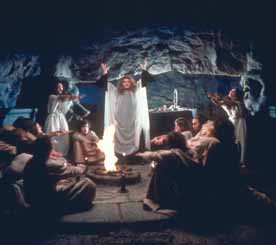 George
Reis: In CRY OF THE BANSHEE, you had Elisabeth Bergner who was a silent
film star.
George
Reis: In CRY OF THE BANSHEE, you had Elisabeth Bergner who was a silent
film star.
Gordon Hessler: She made some very well known pictures. Again, that was Deke Heyward's idea. She was marvelous, out of her depths and aged at the time, and playing a very strange part. But she gave it her everything.
George Reis: Did you know that the American version of CRY OF THE BANSHEE was severely altered? For instance, Terry Gilliam's opening animation sequence was removed and the Wilfred Josephs score was replaced with one by Les Baxter. MGM Home Video thankfully released the uncut British version on VHS and I take it they will eventually do the same on DVD.
Gordon Hessler:
It's amazing. Deke was the one who put that animation in, always being way in
advance of everyone else. About the music, I suspect that Les Baxter was a great
friend of somebody high up at AIP and was doing scores for them at the time.
Perhaps he or someone else saw it and criticized the music, so they were advised
to change it. Wilfred Josep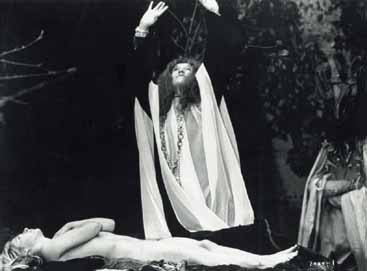 hs
is perhaps not the greatest composer in the world, but he certainly did a good
job. The music is very important to these movies, and to take it off after spending
so much money was a huge decision by somebody. But to have Les Baxter do a kind
of period picture where you have minuet dancing and that sort of thing, it's
ludicrous. You really have to have somebody who has an idea of that time period.
hs
is perhaps not the greatest composer in the world, but he certainly did a good
job. The music is very important to these movies, and to take it off after spending
so much money was a huge decision by somebody. But to have Les Baxter do a kind
of period picture where you have minuet dancing and that sort of thing, it's
ludicrous. You really have to have somebody who has an idea of that time period.
George Reis: Was BANSHEE lower-budgeted that the other AIP films you did? I always heard that they re-used costumes from another film.
Gordon Hessler: Well no, that's not true actually. You see, they have wonderful costumes in England. When they would make a classic period film, something like a Shakespeare film with Richard Burton, all those costumes that were made would go back to the rental house, and they're ready to be rented. And of course you'd get them for practically nothing, so we got all the best costumes. You couldn't get that in Hollywood rental places, everything they had was just awful. MGM Studios had their own costume place, but the rental houses in Hollywood had nothing.
George Reis: The films you did in England had an authentic look to them.
Gordon Hessler: Yeah, it was a gift you know. The gift of hiring the person who had researched all the stuff for a Richard Burton picture, or a big Universal picture of some kind. He would understand the authenticity of what you were trying to do.
George
Reis: In Victoria Price's book about her father, you were quoted as saying
that you didn't think Vincent understood the films you did with him. What did
you mean 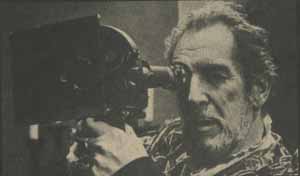 by
that?
by
that?
Gordon Hessler:
Well, he never really understood SCREAM AND SCREAM AGAIN. I don't think he liked
it. He was very upset that he wasn't in MURDERS IN THE RUE MORGUE, but I had
nothing to with that. I really don't know the contractual details though. I
know that when we did CRY OF THE BANSHEE, he was very upset with AIP. When we
had the wrap party, he didn't want to come if Arkoff was there. I told him that
I wouldn't dream of having the party without him. So he came, and of course
he was quite drunk. It was most embarrassing (laughs).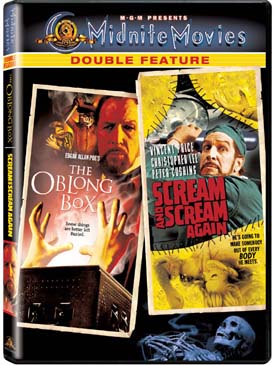
George Reis: He had a tiff with Arkoff at the time?
Gordon Hessler: I imagine it was a contractual tiff of some kind. I never knew what it was about exactly. These after-picture parties are usually so boring, so I requested that everyone dress in costumes, we had hundreds of these period costumes left over. I wanted everybody in costume, including Arkoff and Nicholson. I think we had a naked (or semi naked) girl pop out of a huge cake. But Vincent really didn't want to come if Arkoff was there. He did finally agree, and when we were looking for the knife to cut the cake, Vincent said, "Take the knife that's in my back and use that!"
George Reis: Why did you stop working for AIP?
Gordon Hessler: I think they were upset with MURDERS IN THE RUE MORGUE, at least I suspected that. AIP started to disintegrate after that point. When Arkoff received my letter concerning my thoughts on RUE MORGUE, I'm sure he wasn't too pleased with it, although it was a reasonable letter I thought. But again, we had great fun making those pictures.
George Reis: When your AIP films come out on DVD, they will be presented in the 1.85:1 aspect ratio. Is this the true ratio you were shooting in?
Gordon Hessler: Yes, it would be 1.85. By that time we were composing the films that way, but we were also conscious of the television ratio. We had to be careful because the soundman would always dip his microphone into the picture frame.
Photos are Copyright
© 2002 Metro-Goldwyn-Mayer Studios Inc. All
Rights Reserved.